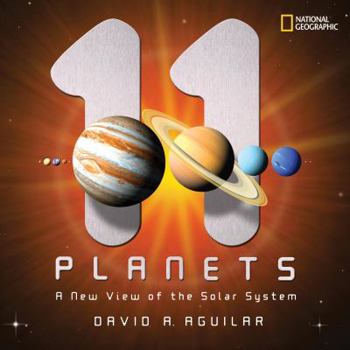11 Planets: A New View of the Solar System
Select Format
Select Condition 
Book Overview
National Geographic proudly presents the essential reference book for what is now officially a NEW AGE in space. In August 2006, the International Astronomical Union redefined the word planet and... This description may be from another edition of this product.
Format:Hardcover
Language:English
ISBN:1426302363
ISBN13:9781426302367
Release Date:March 2008
Publisher:National Geographic Society
Length:47 Pages
Weight:1.00 lbs.
Dimensions:0.4" x 9.2" x 9.3"
Age Range:8 to 12 years
Grade Range:Grades 3 to 7
Customer Reviews
4 ratings
beautiful book
Published by Thriftbooks.com User , 15 years ago
This is a beautiful book I keep on my coffee table. I'm very happy with it.
Beautiful illustrations, easy to read
Published by Thriftbooks.com User , 16 years ago
I bought this book for my daughter a few months ago when she turned 5, and she loves it. It has beautiful illustrations and only one page with info per planet (and sometimes another page for the planet's moons), so it's easy to read. The language is simple enough for a little kid to understand. It also talks about comets, Oort clouds and other solar systems. I like it so much that I've bought a few more for birthday presents.
A simple yet fascinating look at the scientific wonders beyond Earth
Published by Thriftbooks.com User , 16 years ago
Recently, modern astronomers came to a new consensus on how to view the solar system: the relatively tiny celestial body Pluto no longer qualifies as a planet, but is rather a "dwarf planet", and at least two more celestial bodies in our solar system (Ceres and Eris) deserve to be called "dwarf planets" as well. 11 Planets: A New View of the Solar System is an up-to-date look at the planets for inquisitive young minds, filled with fun facts about the eight planets, Pluto the dwarf planet, various planetary moons, Ceres and the asteroid belt, the Kuiper belt and Eris, and more. Illustrated with space photography as well as breathtaking artwork, 11 Planets is a simple yet fascinating look at the scientific wonders beyond Earth, highly recommended for children's library collections.
Nice Little Book
Published by Thriftbooks.com User , 16 years ago
If a third-grader were to ask you how many planets there are in our solar system, how would you answer? Back before August of 2006, it would be pretty simple -- nine: Mercury, Venus, Earth, Mars, Jupiter, Saturn, Uranus, Neptune and Pluto. Ceres, which is found between Mars and Jupiter, was once considered a planet, but in 1850 was reclassified as an asteroid. Growing up in the 1970s and 80s, I looked forward with excitement to the possibility that they would, some day, discover a tenth planet, way out there in the icy wastes beyond Pluto. In 2005, they announced just that -- the discovery of the body now known as Eris, just a tad bigger than Pluto, but three times farther away from the Sun. And then, after lots of arguing back and forth, the International Astronomical Union (IAU) in August of 2006 decided to lump Ceres, Pluto and Eris into a special new category of their own, the "dwarf planet". So now, you'd tell that third-grader that there are eight planets -- unless you include the dwarfs. Basically, the scientists are still arguing about exactly what they mean by a "dwarf planet". Meanwhile, author David A. Aguilar, along with his publisher, National Geographic, made his own decision -- as shown in the newly released book "11 Planets: A New View of the Solar System". I first learned about it when National Geographic announced that a girl named Maryn Smith, of Montana, came up with a nifty new mnemonic for learning the 11 planets: "My Very Exciting Magic Carpet Just Sailed Under Nine Palace Elephants". This appears at the very start of the new book. Now, I'm a bit older than the target age group of ages 9 to 12, but enjoyed flipping through the pages. The book does an excellent job of giving the basic solar system layout in easily understood terms. First, there's the four terrestrial planets, then Ceres and the asteroid belt, then the four gas giants, and finally Pluto, Eris and the Kuiper Belt. And a little bit about the Oort Cloud, meteors, comets and planets around other suns. And our own Sun, of course. Each section has a little discussion of the god, or goddess, the planet was named after (such as Ceres, the goddess of agriculture), along with nice drawings of the planet and its moons, if any. Included are some interesting facts, such as Jupiter's Giant Red Spot having existed for hundreds of years, or that Uranus is on its side, not more or less upright like the other planets. There are separate sections for Earth's moon, as well as the moons of Jupiter and Saturn. In back is a handy glossary and a table showing how much children of various sizes would weigh on various planets -- at least, those with a solid surface. To give your budding astronomer some idea of the relative sizes of the planets, there's a fun list of ingredients you can buy from the store (a grapefruit, an orange, peas, a cherry tomato, a grape, some sugar, baking soda and salt) and how you can lay them out -- if you don't mind walking 1000+ yard





